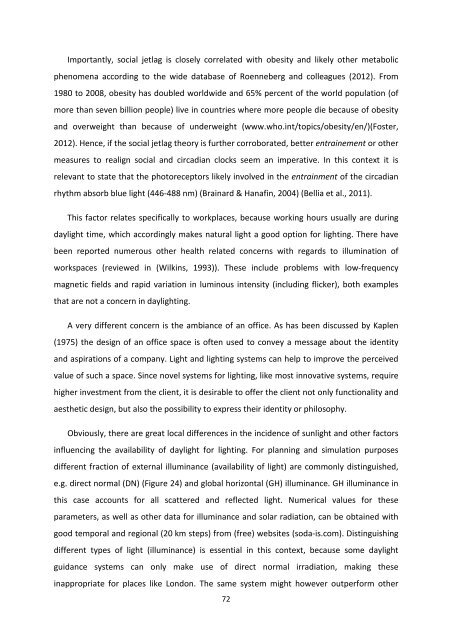MASTER THESIS Biomimetic potential of sponge ... - IAP/TU Wien
MASTER THESIS Biomimetic potential of sponge ... - IAP/TU Wien
MASTER THESIS Biomimetic potential of sponge ... - IAP/TU Wien
Create successful ePaper yourself
Turn your PDF publications into a flip-book with our unique Google optimized e-Paper software.
Importantly, social jetlag is closely correlated with obesity and likely other metabolic<br />
phenomena according to the wide database <strong>of</strong> Roenneberg and colleagues (2012). From<br />
1980 to 2008, obesity has doubled worldwide and 65% percent <strong>of</strong> the world population (<strong>of</strong><br />
more than seven billion people) live in countries where more people die because <strong>of</strong> obesity<br />
and overweight than because <strong>of</strong> underweight (www.who.int/topics/obesity/en/)(Foster,<br />
2012). Hence, if the social jetlag theory is further corroborated, better entrainement or other<br />
measures to realign social and circadian clocks seem an imperative. In this context it is<br />
relevant to state that the photoreceptors likely involved in the entrainment <strong>of</strong> the circadian<br />
rhythm absorb blue light (446-488 nm) (Brainard & Hanafin, 2004) (Bellia et al., 2011).<br />
This factor relates specifically to workplaces, because working hours usually are during<br />
daylight time, which accordingly makes natural light a good option for lighting. There have<br />
been reported numerous other health related concerns with regards to illumination <strong>of</strong><br />
workspaces (reviewed in (Wilkins, 1993)). These include problems with low-frequency<br />
magnetic fields and rapid variation in luminous intensity (including flicker), both examples<br />
that are not a concern in daylighting.<br />
A very different concern is the ambiance <strong>of</strong> an <strong>of</strong>fice. As has been discussed by Kaplen<br />
(1975) the design <strong>of</strong> an <strong>of</strong>fice space is <strong>of</strong>ten used to convey a message about the identity<br />
and aspirations <strong>of</strong> a company. Light and lighting systems can help to improve the perceived<br />
value <strong>of</strong> such a space. Since novel systems for lighting, like most innovative systems, require<br />
higher investment from the client, it is desirable to <strong>of</strong>fer the client not only functionality and<br />
aesthetic design, but also the possibility to express their identity or philosophy.<br />
Obviously, there are great local differences in the incidence <strong>of</strong> sunlight and other factors<br />
influencing the availability <strong>of</strong> daylight for lighting. For planning and simulation purposes<br />
different fraction <strong>of</strong> external illuminance (availability <strong>of</strong> light) are commonly distinguished,<br />
e.g. direct normal (DN) (Figure 24) and global horizontal (GH) illuminance. GH illuminance in<br />
this case accounts for all scattered and reflected light. Numerical values for these<br />
parameters, as well as other data for illuminance and solar radiation, can be obtained with<br />
good temporal and regional (20 km steps) from (free) websites (soda-is.com). Distinguishing<br />
different types <strong>of</strong> light (illuminance) is essential in this context, because some daylight<br />
guidance systems can only make use <strong>of</strong> direct normal irradiation, making these<br />
inappropriate for places like London. The same system might however outperform other<br />
72

















